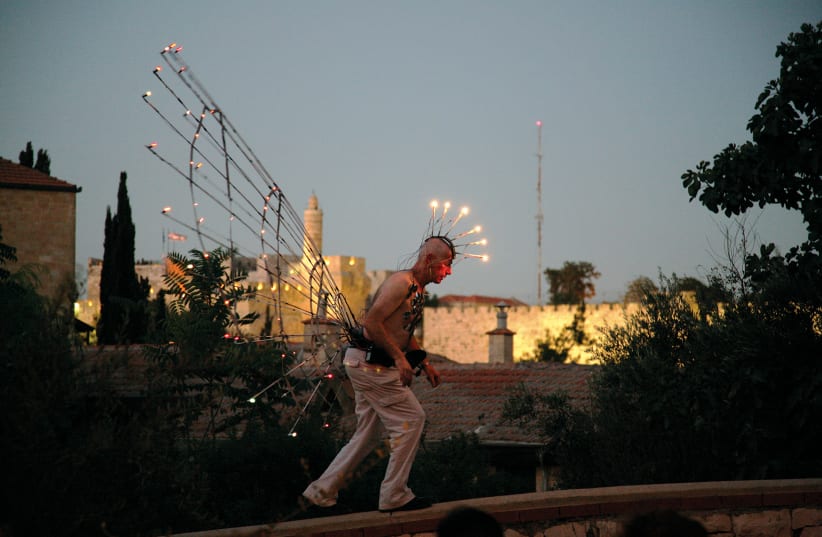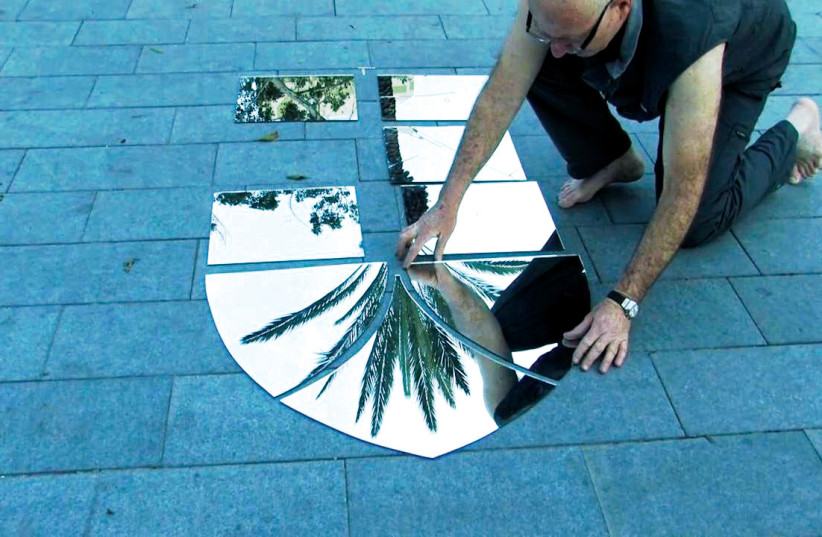There doesn’t seem to be much that Jerusalemite Hadas Ophrat has not taken on, with all guns blazing, during the course of his long career in the arts. Succinctly put, the 72-year-old Israel Prize laureate could be labeled a multidisciplinary artist.
As a generic moniker, that does the trick. But there is so much ground to dip into, to get some kind of grasp of the breadth and depth of his oeuvre and philosophy.
A run through his impressive bio can leave you gasping for breath. The Jerusalem arts and culture scene owes much to Ophrat, who founded The School of Visual Theater and co-founded Hazira-Performance Art Arena, and the Train Theater. The latter also provided Ophrat with the opportunity to adapt some of the wisdom and experience he accrued during a two-year sojourn in Japan, where he studied traditional Bunraku and Noh theater.
He also earned a degree in literature and philosophy at Tel Aviv University, and subsequently completed a master’s degree at the Faculty of Architecture and Urban Planning at the Technion Institute of Technology in Haifa, focusing on art intervention as a tool for urban renewal.
The art of Hadas Ophrat at Jerusalem's Musrara Mix Festival
Ophrat is one of the headliners at this year’s Musrara Mix Festival, which will take place May 30 to June 1 at its perennial berth, the Naggar School of Photography, Music and New Media. As the institution’s title suggests, it keeps its artistic options open. That suits the irrepressible eclectic-leaning septuagenarian down to the ground as he brings his hefty professional experience to his Darkroom installation, which will gradually take shape over the course of the two days.
The reference to the dimly lit image-developing sanctum seems a neat fit for a school that began life exclusively as a photographer training vehicle. But, as is Ophrat’s wont, the upcoming project is not a straight-ahead photographic undertaking; far from it. While images will emerge as the work progresses, the installation and durational performance venture is not at all about taking a bunch of negatives – if anyone out there remembers the analog photography raw material – dipping them in a slew of chemical solutions and obtaining an image in a corporeal print.
For Ophrat, the darkroom and the activity that takes place there are akin to the human gestation stage as the embryo begins to take on a recognizable form. “The darkroom is the womb, where images emerge,” he notes. It is not just about the pictorial bottom line. Ophrat says that ideas begin to take shape, too.
“It is a place where my consciousness develops,” he adds, moving straight into an adjacent area of the visual arts. “There is the monumental [1966] movie by [Italian director Michaelangelo] Antonioni, Blowup, when the main character looks at the prints coming out in the darkroom, and he begins to discern a dead body in one of them.
“That is exactly the situation in which images begin to come out and take on some kind of order, sometimes clashing with each other, and sometimes you uncover something or you think you have discovered something. There is no lie. There is truth and imagination. That is where the image is born. The image comes from consciousness.”
That was quite a notion to take on, particularly in a post-fake news world in which the virtual often completely takes precedence over the tangible. Ophrat expands on the aforementioned Blowup scene. He likes to keep things open, rather than nailing them down to some tried and trust – but limiting – tag.
“It doesn’t matter whether or not there was a dead body. Reality is not one-dimensional. There are realms of hallucination, or the area of ‘it looks like,’ or the Twilight Zone. I like to keep things in the Twilight Zone. I like the place where the [real or imagined] image and reality exist. I believe we are more creative there, more sensitive, more open there than when we take the rational approach and declare that white is white and black is black.”
PHOTOGRAPHY COMES up numerous times during our tête-à-tête at Ophrat’s airy home in the German Colony, in all sorts of shapes, hues and contexts. And it is more the process that underpins the art form than the result thereof that takes center stage in Darkroom which, Ophrat explains, feeds off the dynamic of creation and how the artist approaches the creative continuum.
“I prefer to be in a state of doubt, hesitancy, wonder,” he says. “I think intuition is more present in that sort of circumstance. There is more vibrancy there.”
We return to the ethereal and nebulous. “When I wake up from a dream, I like to keep my eyes closed and hover in the no man’s land between a dream state and wakefulness, the transition between awareness and the subconscious. I think that ‘in-between’ place is important.”
He brings another field of the arts into his referential fray. “[Celebrated 20th-century American landscape photographer] Ansel Adams once said, about the relationship between photography and music, that the negative is the notes of the musical work, and the print is the performance.”
The latter has been a major part of Ophrat’s publicly aired work, and thinking, for some years now. He adopts a bare-fisted approach to the presentation format, sparing no physical effort to produce the aesthetic thought-provoking goods.
In 2010, for example, he contributed to the celebratory events that marked the grand reopening of the Israel Museum. His berth in the Contact Point program included his Not in Heaven performance work in which he spent five long hours on his knees to recreate the ornate ceiling of the 18th-century Horb am Main synagogue, in Germany, using carefully crafted mirrors to form the image of a prayer carpet.
Mirrors comprise a major component of the design and thinking behind Darkroom too, feeding off both historical and technological references. For starters, there is the simple fact that cameras are equipped with a mirror, which enables the photographer to see the subject he or she wants to capture. The Musrara Mix installation features framed mirrors of varying sizes, stretching the full height of one wall. That harks back to the heyday of the Salon de Paris art exhibition, which was the Western world’s preeminent art roll-out from the mid-18th century through to the late 19th century.
The component of the camera mechanics resonates in the structural layout of the Darkroom, as Ophrat treads a fine line between the light and dark divide that lies at the root of the documentary discipline. He will manipulate that ebb-and-flow dynamic by gradually allowing more light to seep into the darkened section from the brightly illuminated back area. That will materialize as Ophrat applies an engraving tool to the rear side of the mirrors to create linear shapes that resemble the spindly form of a mosquito and other insects. By so doing, he produces something similar to light sketches that offer visitors views of a negative of the image, much along the lines of the analog photography process.
There is a twist to the Darkroom activity, whereby the insects not only become visible to the viewers but are also superimposed on their faces in much the same way that visual effects are added to movies during the editing stage.
SHOULD WE so desire, we will be able to see what goes on behind the scenes, how the magic comes to be in a – possibly unintentional – nod to Bunaraku theater, where the audience sees how the puppeteers maneuver the puppets. Rather than wowing us with gimmickry, Ophrat is more than happy for the public to be privy to the way the work comes together.
“There is a difference between magic (“kesem” in Hebrew) and being charmed (“hikasmut” from the same root). That’s what politicians do, to try to fool us,” he adds with a wry smile.
Putting in a shift or two to get the art installation deed done is nothing new to Ophrat who, despite being some way past the spring chicken stage, maintains a zest for innovative creation and a burning desire to pose questions, including of the taxing overtly provocative kind, in an effort to pique our interest.
The corporeal – a definitive, first-person physical presence – forms the core of much of Ophrat’s work. The aforementioned Israel Museum performance was an exacting experience, and his extensive and expansive output to date features numerous creations fueled by political statements that dip into all sorts of spheres.
His 2001 Milky Way live art venture saw him pace around Kibbutz Nachshon, hour after hour, carrying a weighty contraption with udder-like appendages brimming with sheep’s milk. As the time elapsed, and the maternally provided liquid was warmed by the sun, and Ophrat’s naturally rising own body heat, nature took over and the milk began to turn into cheese. The artist described the solidifying transformation as the result of his “independent productive body” which, when you think about it, is something we all have.
Ophrat tends to go the extra hundred or so miles to express his own ideas and feelings, wherein lies the crux of his artistic ethos. There is an ever-present checks-and-balances dynamic to his work, and personality, balancing the cerebral against the emotional.
He talks about following an intuitive path to his artistic goals. Then again, he does not set his sights on an aesthetic end product and simply goes for it. He talks about “the search” as a leitmotif of his efforts, and rails against Pablo Picasso’s belief that “The meaning of life is to find your gift.”
“That really annoys me,” he says. “I don’t find things. I look for them. That is what it is all about.”
And he looks for them here there and everywhere, including right at the heart of urban hustle and bustle. One such venture saw him spend hours on a traffic island near the Azrieli Center in Tel Aviv, posing as a beggar in a patently supplicatory submissive pose. The interaction between urban dynamics, of a human and architectural nature, feature frequently in Ophrat’s oeuvre.
He is at pains to differentiate between space and place. “Place refers to the physical structure and its characteristics. Space holds the potential for relation and a personal and interpersonal experience,” he notes.
Space is very much part of Darkroom, albeit initially clearly partitioned off. But, as is often the case with Ophrat’s work, demarcation lines tend to shift as the viewer’s preconceptions and grasp of the dynamic in question are challenged.
“As you enter the Darkroom, your eyes gradually become accustomed to the dim light, and you begin to discern the framed paintings on one wall, like in the Salon,” he explains. “But they aren’t the paintings themselves. It is a mirror. You only see the reflection. You also see your own reflection.”
The sensorial plot thickens. “I use a multi-tool device, including an engraving tool, and you hear the buzzing sound it makes,” he continues. “Then light begins to seep in.”
The visual and aural conjoin, as Ophrat utilizes his skills as a sculptor, removing parts of the mirror in order to create something new. “Lefasel (“to sculpt” in Hebrew) comes from the same root as lifsol (“to take away”),” he enlightens me. “The insects that begin to appear look like they are alive.”
Then again, the bugs are not the point. “This is a work about large and small, and about the relationship between them and us, and how we fuse. The Darkroom is about the birth of an idea.”
The installation and durational performance promises to provide a compelling experience. “Performance art does not tell a story per se,” Ophrat notes. “It is often a repetitive act that can be wearisome, but suddenly something emerges. That is the exciting part.” ❖
For more information about Musrara Mix, visit www.musraramixfest.org.il/he.













